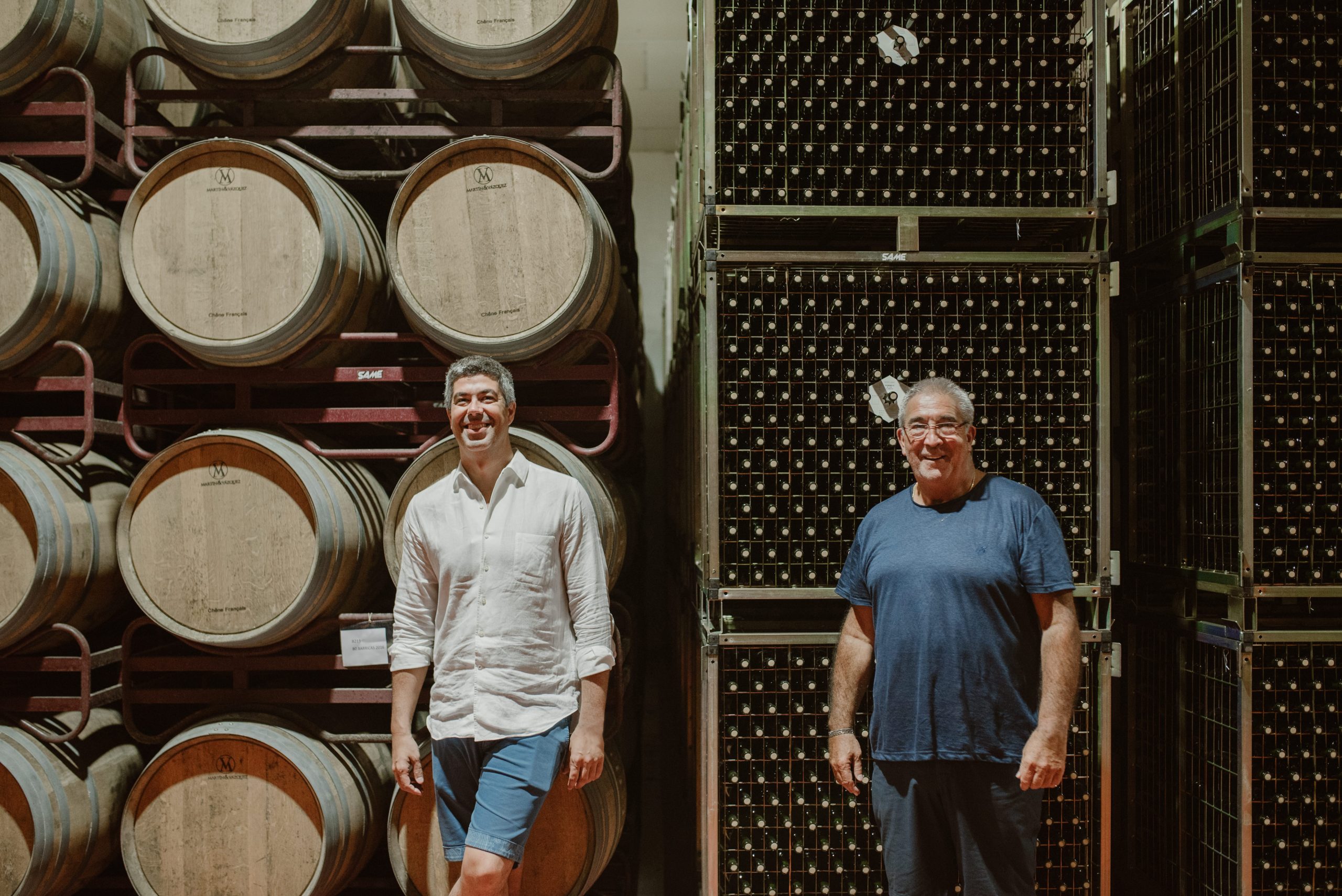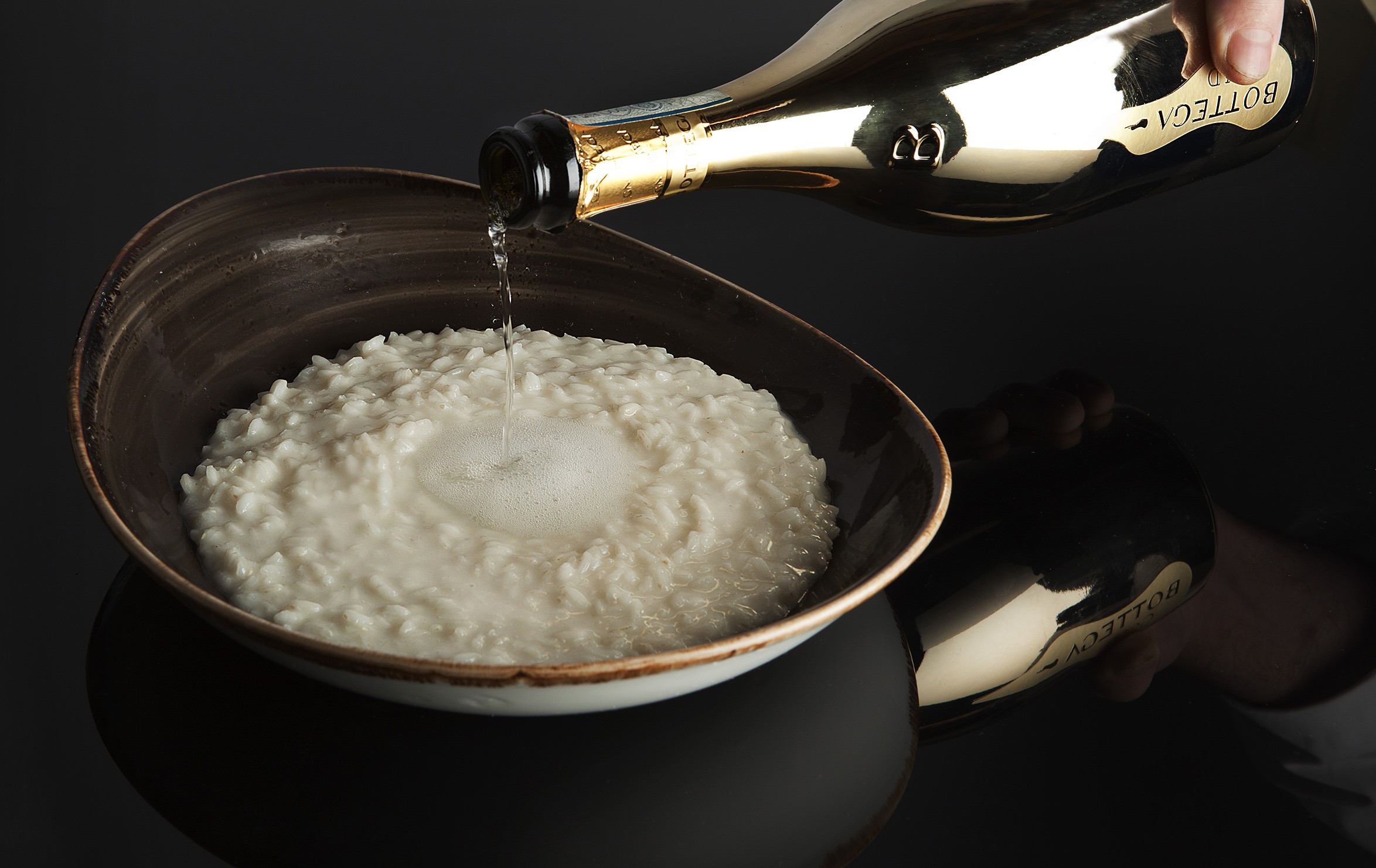Wine List Confidential: Killiecrankie House
Douglas Blyde finds “avant-garde” dishes and a plethora of sake pairings at Matilda Ruffle and Tom Tsappis’ “secluded” Perthshire restaurant Killiecrankie House.
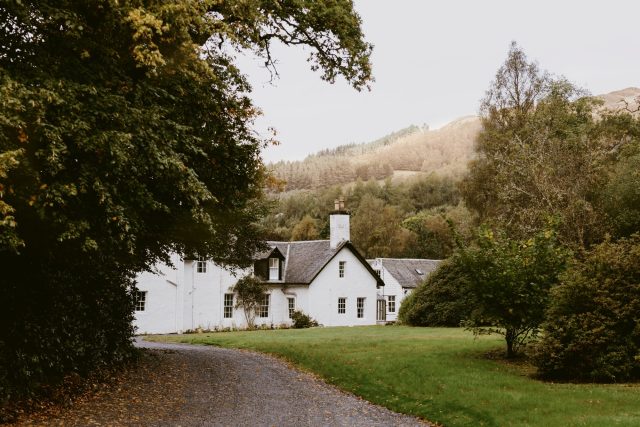
Meaning “aspen” in Gaelic, Killiecrankie House, a scenic stroll from Queen Victoria’s beloved village of Pitlochry, and the 40-metre high, Highland Fling bungee jump site, was praised by New York Times for its “boundary-pushing tasting menu with lots of cheek and zero haughtiness” and “plucky” drinks accompaniments, while The Scotsman appointed it Scottish Restaurant of the Year 2023.
Design
Once a vicarage, Killiecrankie House was previously run by eminent hotelier, Henrietta Fergusson who so cherished the venue that she would only leave it in a casket. It was subsequently acquired by trained sommelier, Matilda Ruffle and her Leith’s diploma-holding chef husband, Tom Tsappis in November 2020 when the pandemic expedited a five-year dream to find, says Ruffle, “the perfect spot for a restaurant with rooms.” They previously ran an often twice-weekly BYOB supper club with decent glassware, “Elia” (olive tree) from their one-bedroom flat in East Dulwich.
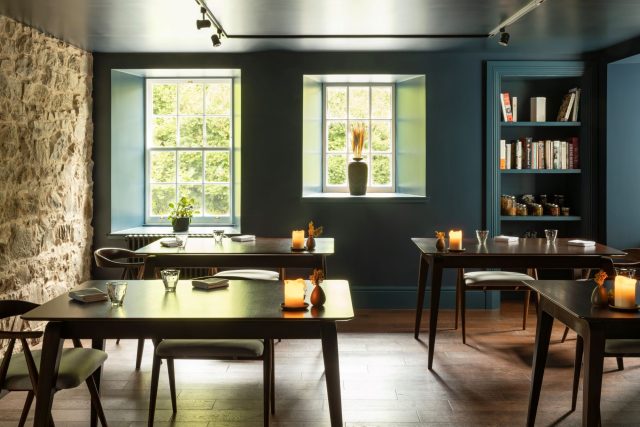
With no central heating, the couple’s first Perthshire winter was uncomfortable. Snow mounted around the building as temperatures plummeted to minus 16 degrees Celsius. “Henrietta was known to send guests to bed with a hot water bottle and a miniature of whisky,” says Tsappis when quizzed on how guests would have coped under Fergusson’s tenure. Subsequent progress of the near total rehabilitation of the building, including new foundations where mud had been before, and a full overhaul of plumbing, heating, and wiring, was charted on a dedicated Instagram account, “Killiecrankie House Renovation”. The result is an open-plan, cobalt-coloured dining room with animal pelts draped over seats facing a bright, stage of an open kitchen with Victorian-effect tiles, arranged where one of 11 bedrooms had been before. Here, the picture of a leek was gifted by the Scottish painter, James Fairgrieve RSA, RSW in consideration of his stay, when he had been impressed to see two of his other paintings, of gourds and a haggis, already on display. There is also a cosy lounge, a marble counter bar featuring an amusing picture of a woman dining with a pig called “Pattern of Unfulfillment” by American artist, Claire Shaw, and five spacious bedrooms above.
Notable is the playlist, chosen by a different team member each evening, delivered via a retro Marshall record player. On our visit, Tsappis’ selection ranged from Isaac Hayes’ “Hyperbolicsyllabicsesquedalymistic”, played to crescendo as guests, including an executive from DC Thomson who had strong thoughts on music, entered the dining room, to “How Many Mics” (Fugees), via Daryl Hall & John Oates’ “Kiss On My List”.
A team of just eight, including a housekeeper and a full-time gardener tending the extremely important kitchen garden, look after around 16 guests.
Drinks
With roots reaching to Fife and Japan, Ruffle, who recently took part in the Gosset Matchmaker competition despite the wines of the Maison not being served at Killiecrankie, previously worked as lead strategist at an advertising agency. Given her main client was Dettol, this role “went into overdrive during the global pandemic,” she recalls.
Wines at Killiecrankie House must “foremost be delicious.” The sparkling selection includes 2010 Seyval Blanc, Cuvée Koizumi Yakumo, a homage to winemaker, Peter Hall’s great-great uncle, a travel writer born to Greek/Anglo-Irish parents. This is priced at three times retail. Other options by the bottle include 2020 Wehlener Sonnenuhr Kabinett Mosel Riesling by Joh. Jos. Prüm, and Clos Cibonne’s Côtes de Provence Tibouren Rosé 2019, both marked up two-fold. A similar markup applies to big-hitter reds, displayed on neat racks tailored in Denmark, including an albeit rather young Ornellaia 2018. Gusbourne’s 2020 Guinevere Chardonnay, and on the insistence of Tsappis, Château d’Yquem 2008 are poured via Coravin.
In collaboration with Oliver Hilton-Johnson of Tengu, Ruffle has cultivated what is for Scotland, a burgeoning sake selection with room to expand into territories such as Hokkaido, which also informs cocktails. Delivered by bar supervisor, Niall Aitken (formerly of Dornoch Castle Hotel), the “Old & New Fashioned” stars the oaky “marmite meets PX” says Ruffle, Shirayuki Edo Genroku Redux, a barely polished, spontaneously fermented, Junmai allegedly made to a 321-year-old recipe. This meets Dewar’s White Label and chocolate bitters. Although conventional in appearance, the result is a bold drink with a long, sauce-like aftertaste.
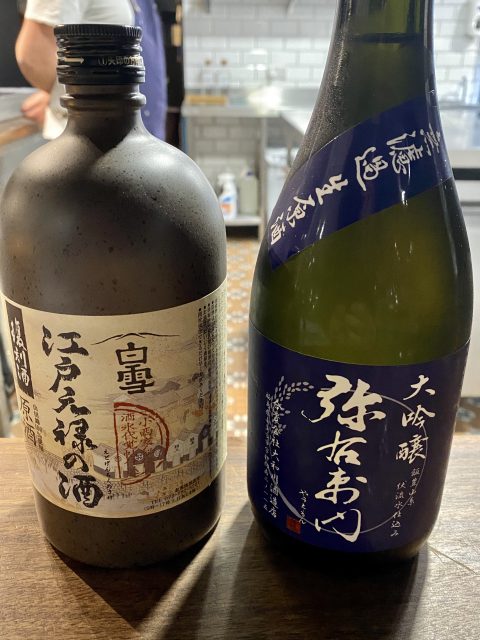
Given the gloriously remote setting of Killiecrankie, non-alcoholic pairings, featuring products such as Wild Eve from the Isle of Harris, are taken seriously in consideration of guests who have driven. “We established this even before a vegetarian menu,” says Tsappis, while Ruffle notes, “it would pain me to see guests with no alternative to drink other than Coke.”
Ruffle is assisted by junior sommelier, Lauren Henderson.
Dishes
“We’re eaters first,” says former FX broker, Tsappis. Indeed, this is a couple willing to travel for not only delicious but provocative food – to Maeemo last November, followed by a round trip over one day to Pine in January. Then there was the team trip to Restaurante Akelare in San Sebastián. Towards the end of the year, they will head to Alchemist, Copenhagen, then on to Hong Kong and Japan “to fill our boots” says Ruffle.
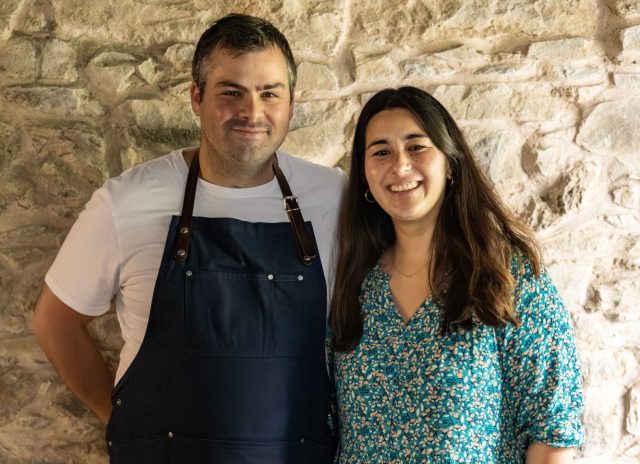
Compared to the albeit well-regarded but dated previous incarnation of Killiecrankie House, which offered an a la carte “rooted in French technique”, says Tsappis, today’s ever-changing, blind menu runs between 14-20 courses, “inspired by the structure of Kaiseki”.
After snacks of a taco of venison tartare, nasturtium and charcoal served in a locally made Masu-esque cup, then a cucumber sandwich with lemon gel and taramasalata – showing Tsappis’ Greek Cypriot heritage, Pied Piper-like, guests followed the sound of “Hyperbolicsyllabicsesquedalymistic” to the dining room.
From the £75 “Discovery” drinks pairing, Ruffle poured stone fruit scented, traditional method Lumière Koshu 2016 from Japan with a quartet of opening dishes, beginning with crispy, umami to the fore, cep panisse, a particularly pretty courgette wrapped “maki” of sea bream, pickled elderflower, and wasabi, which, like the majority of grown ingredients, had been skilfully raised in Killiecrankie’s garden. Offering two experiences in one, the “salmon cornetto” of tightly seaweed-wrapped sliced salmon belly was finished with piped, smoked, sesame-dotted salmon. And last, but not least in this round, was the perennial, comforting “dripping fried porridge” bar taking inspiration from “a time porridge was poured into a drawer in the kitchen dresser and left to set before being sliced into bars,” said Tsappis. This thoroughly upgraded, successful dish featured Highland wagyu dripping, and 16-hour braised oxtail at its core, finished with wisps of tangy Isle of Mull Cheddar.
Partner Content
Next, a double sake pairing of two contrasting styles occurred: clear, highly polished Yauemon Snow Blossom Daiginjo Nama Yamatogawa Shuzo from a two-century-old brewery in Fukushima, and the iodine-coloured Redux from Hyogo. The appealingly named Snow Blossom paired best with the flesh and roe of locally raised trout featuring in the “Scotch Egg”, a dish so-called because, literally, it contains whisky and is served in a ceramic egg, while the rugged Redux met a generously relatively heatless mustard pepped, sake-braised, black garlic honey glazed, crispy leek adorned, sliced daikon which had been grown in a barrel to elongate it. Although tonight’s most polarising dish, it proved so interesting, especially alongside the ancient seeming sake, that it was impossible to stop eating.
Our eyebrows raised as a can of aspen leaf motiffed lager appeared for the next pairing, with the black, not bleak, dish of diced North Sea squid which had been gently poached for a considerable time, with chopped capers and confit fennel, and sauce of reduced cooking stock and ink, with a wild garlic emulsion taken from a batch of some 30 kilograms handpicked by Tsappis. The dry-hopped lager, on its way to becoming an IPA, was made especially for Killiecrankie House at local craft brewery, Wasted Degrees in Blair Atholl, whose founders, apparently wasted their university degrees by bailing out of the corresponding professions… Complete with a portable stove, Tsappis recalls having a wonderful time testing the various iterations of the beer at the brewery, “ultimately landing on a dry-hopped lager, which brings a refreshing lightness to the intense dish,” says Ruffle, with “the hops giving a citrussy pithiness that cuts through all the richness.”
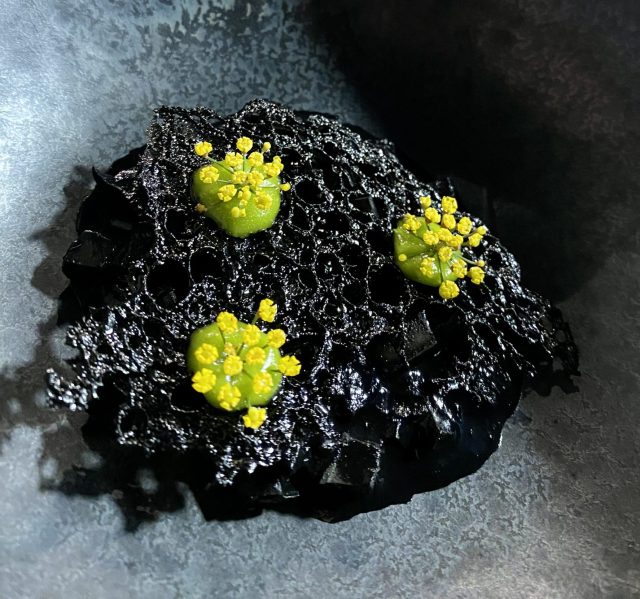
Though not topped up, the lager was intended to continue with “chewy roots”, a little tart resulting from a lot of work, topped with around 10 Michelin-like emblems, being “the number of stars I’d like to win” Tsappis half-joked when prompted. The celebration of blue cheese mornay saw “badly treated beetroots” cooked, dehydrated then rehydrated in a homemade blueberry vinegar, with wild garlic stem kimchi, evoking the bite of ginger.
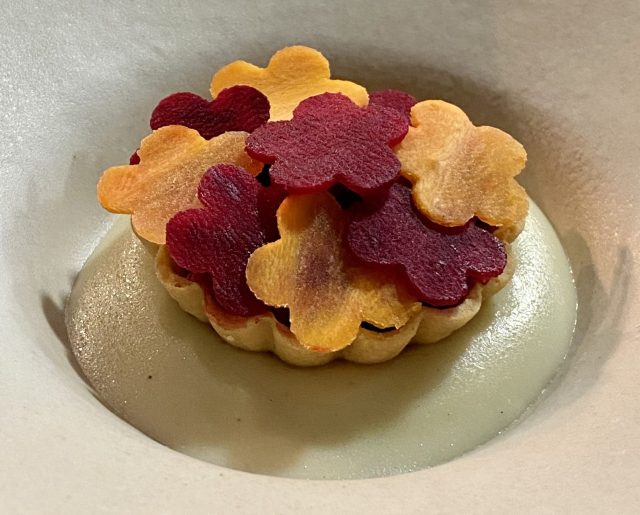
Another imaginative dish, this time created by ambitious sous chef, Huw Williams, celebrated the humble potato, here treated “as if it was rice”, said Tsappis. The textured “risotto” featured potato cooked with a stock of brown butter and mussel dashi, pickled seaweed and mussels, crispy buckwheat, and smoked potato foam made from the trim of the potatoes. This was then dusted with powdered seaweed and fried potato skins. It was paired with an old oak-aged, creamy, supple Pinot Blanc-Chardonnay from Baden producer, Schlipf Schneider – Vom Kalkstein Le Blanc Baden 2019.
Accompanied by a serious looking Maclean of Braemar knife, venison, from the top end of the loin, versus the tail end/thin end of the loin used for the canapé, was glossed with a Japanese style BBQ glaze made with sake, tamari, mirin, port, and treacle. This met a 2016 Petit Verdot-Arinarnoa (the latter, a crossing of Tannat with Cabernet Sauvignon) from the turreted, galleried, château at Treaty Port Vineyards, Shandong, which Ruffle revealed was founded by her father, Chris, in 2004. “He was the first to establish a vineyard in the region, which now boasts seven vineyards, including Château Lafite Rothschild, who last year bought the majority of my dad’s Treaty Port vineyard.” It featured Prince Gong on the label, the Prince Regent from 1861-1884 who championed “friendly relations with the West and China”. The shot of the simultaneously relaxed and severe-looking fellow was taken by Scottish photographer, John Thomson. Although the most conventional-looking dish tonight, there was much work in its construction, including the beetroot hoisin puree, venison jus made with Shaoxing rice wine and pickled blueberries, and in the accompaniments of pillowy Hokkaido-style milk bun, and brilliantly messy seaweed-herb butter which evoked desiccated coconut in taste.
For the “cheese course”, the headily titled, Blue Murder selected by Tsappis from the mobile showroom of affineur, Pierre, “who couldn’t have a more French name”, was baked into a Basque-style cheesecake served with a lightly fermented apple syrup, oat granola, Bramley apple sorbet and frozen grated blue cheese. This met 2013 Commandaria Kyperounda Xynisteri, matured in former Chardonnay barrels, brought back from Cyprus in a suitcase. “Commandaria was served at Richard the Lionheart’s wedding”, said Tsappis.
Dessert proper saw a bold in appearance yet balanced red and pink dish of more beetroot, rhubarb and rose served with cherry blossom tea, followed by a little Irn Bru gummy, which was “hard to set” said Tsappis given the drink’s distinct lack of fruit, a miso toffee wrapped in initially bewildering clear edible wrapper, a raspberry canelé topped with a solitary black grape, homegrown to ripeness in the on-site polytunnel, and, madeleines made, brilliantly, of Stornoway black pudding.
Last word
While Tsappis’ formal training saw him attend the one-year, three-term professional diploma at Leiths School of Food and Wine, the dishes at Killiecrankie House felt avant-garde, perhaps showing influence from The Man Behind The Curtain, where he once undertook a stage, as well as the plethora of fearless eateries he and Ruffle so love to frequent around the world. As a fellow big hitter eater mentioned on Instagram, Killiecrankie House can come across as “a pretty niche find”. Indeed, Tsappis and Ruffle, with resourceful, structured, original cooking, fascinating drinks matches, and a secluded location one will not arrive at by accident, have found their niche here in the Highlands, combining their skills to make coming here a magical affair.
Best for
- Seasonal cocktails, which previously included the “Killiecrankie Cure-All” for the cold Perthshire winters
- Whisky selection, including Daftmill bottlings, and custom whisky tasting experience
- Sake
- Chef’s counter for two
- Breakfast, including plum jam from Ruffle’s mother’s garden
Value: 95, Size: 91, Range: 94, Originality: 97, Experience: 98; Total: 95
Killiecrankie House – Perthshire, PH16 5LG; 01796 473213; hello@killiecrankiehouse.com; killiecrankiehouse.com
Killiecrankie House will be participating in the Sake Seafood Sensations campaign throughout October, showcasing the harmony and compatibility of sake with seafood.
Blyde recently also interviewed Ruffle about the restaurant’s story and its various drinks lists.
Related news
Carlsberg boosts presence in China with restaurant guide tie-up


